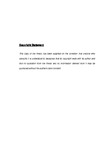Authenticity and Quality of Muscle Foods: Assessing Consumer Trust and Fraud Detection Approaches
| dc.contributor.supervisor | Kuri, Victor | |
| dc.contributor.author | Salih, Salih Mustafa | |
| dc.contributor.other | School of Biological and Marine Sciences | en_US |
| dc.date.accessioned | 2017-12-06T14:24:51Z | |
| dc.date.available | 2017-12-06T14:24:51Z | |
| dc.date.issued | 2017 | |
| dc.date.issued | 2017 | |
| dc.identifier | 10195183 | en_US |
| dc.identifier.uri | http://hdl.handle.net/10026.1/10384 | |
| dc.description.abstract |
Authenticity issues and fraudulent practices regarding animal products are affecting consumer confidence. Verifying the description, composition, processing or origin of foods can be challenging. To explore British and Kurdish consumers’ perceptions of kebab meat products, focus groups and questionnaire surveys were applied. About 40% of participants in the UK tend to purchase fewer processed meats after the European horsemeat scandal. Issues raised by participants indicated their concerns about the declaration of species, meat content, and other ingredients incorporated in kebab and other meat products. Lack of consumer trust has been linked to authenticity issues. Reactions towards the addition of fat-replacing inulin were positive by more than half of respondents. A further study aimed to investigate the effect of commercial inulin (CI) and Jerusalem artichoke (JA) tubers as fat replacers on the eating quality and overall acceptability of kebabs. Inulin flour prepared from JA by a simple protocol presented advantages with about 10% higher cooking yield and overall acceptability when compared with CI. Levels of inulin as low as 0.5% were detected in meat products using enzymatic assay, which could be relevant to detect additives and enforce labelling requirements. The authenticity (origin and species) was investigated in fish samples from commercial markets in Erbil, Kurdistan Region of Iraq (KRI). The declared fish species was checked using DNA barcoding with Cytochrome b region. A 10 % rate of mislabelling occurred only for wild common carp (Cyprinus carpio), with 9 out of 12 discovered to be the related species goldfish (Carassius auratus), which was deemed to be accidental rather than deliberate fraud. Such occurrences were from street markets and fishmongers, while none were from supermarkets. Wild and farmed common carp samples were not discriminated by DNA barcoding. Further fingerprinting using compositional profile and nearinfrared spectroscopy (NIRS) together with chemometric analysis aimed to predict composition and discriminate between wild and farmed common carp and species identity. NIRS-predictions of composition and some macrominerals of fish have a strong correlation with the references. NIRS with chemometric analysis is promising, but were not satisfactorily accurate for micro-minerals. Even with no clear solution from principal component analysis (PCA), NIRS-PCA may contribute to discriminating sample groups, but not for authentication when used alone. Having reliable techniques for authentication of food of animal origin may discourage deliberate replacement in retail, wholesale and international trade, and may contribute to reductions in food mislabelling, therefore protecting consumers from fraudulent practices. | en_US |
| dc.description.sponsorship | Ministry of Higher Education and Scientific Research, Kurdish Regional Government (KRG) – Iraq, through the Human Capacity Development Program (HCDP) scholarship | en_US |
| dc.language.iso | en | |
| dc.publisher | University of Plymouth | |
| dc.rights | CC0 1.0 Universal | * |
| dc.rights.uri | http://creativecommons.org/publicdomain/zero/1.0/ | * |
| dc.subject | Food Quality | |
| dc.subject | Animal Origin | |
| dc.subject | Consumer Trust | |
| dc.subject | Fraud Detection Approaches | |
| dc.subject | Food Authenticity | en_US |
| dc.subject.classification | PhD | en_US |
| dc.title | Authenticity and Quality of Muscle Foods: Assessing Consumer Trust and Fraud Detection Approaches | en_US |
| dc.type | Thesis | |
| plymouth.version | publishable | en_US |
| dc.identifier.doi | http://dx.doi.org/10.24382/1000 | |
| dc.rights.embargoperiod | No embargo | en_US |
| dc.type.qualification | Doctorate | en_US |
| rioxxterms.version | NA |
Files in this item
This item appears in the following Collection(s)
-
01 Research Theses Main Collection
Research Theses Main



